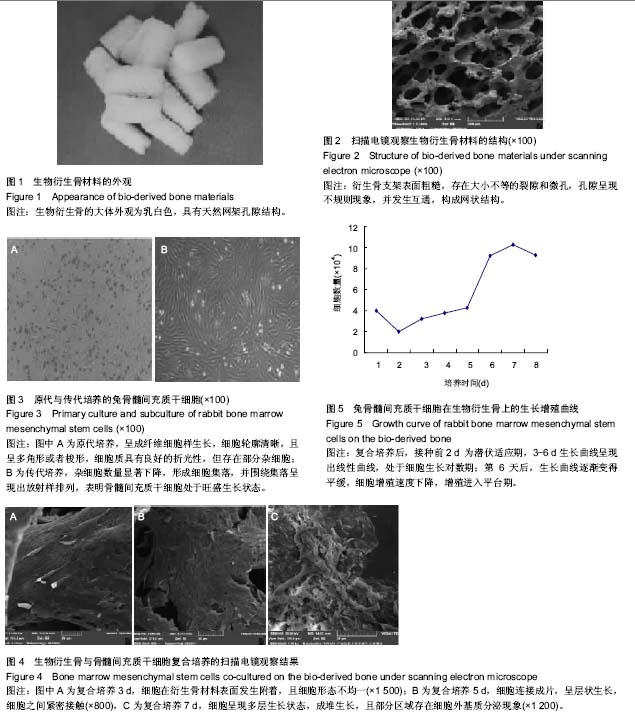| [1] 朱肖奇,马雪峰,贺用礼,等.生物衍生骨复合成骨诱导骨髓间充质干细胞构建组织工程化骨修复兔桡骨-骨膜缺损的血管化进程[J].中国组织工程研究与临床康复,2008,12(27):5226-5229.
[2] 朱肖奇,贺用礼,马雪峰,等.生物衍生骨与骨髓间充质干细胞复合修复免桡骨大段缺损[J].中国组织工程研究与临床康复,2009, 13(3):417-422.
[3] 王之允,董长和,杨敏云,等.兔骨髓间充质干细胞复合生物衍生骨修复胫骨缺损[J].中国临床康复,2006,10(13):76-78.
[4] 罗道明.柚皮甙诱导BMSCs复合生物衍生骨构建组织工程骨的实验研究[D].广西中医药大学,2012.
[5] 马雪峰,朱肖奇,贺用礼,等.生物衍生骨体外复合构建组织工程化骨修复兔桡骨-骨膜缺损:血管化进程及其生物力学性能[J].中国组织工程研究与临床康复,2010,14(12):2097-2100.
[6] 黄晓兵,刘霆,孟文彤,等.骨髓间充质干细胞诱导成骨细胞模拟造血龛支持造血干/祖细胞增殖[J].中华血液学杂志,2006,27(12): 795-800.
[7] 张乃丽,李宝兴,赵亚平,等.生物运行骨材料与骨髓间充质干细胞体外的生物相容性[J].中国组织工程研究与临床康复,2008, 12(49):9766-9770.
[8] 马雪峰.组织工程化骨修复兔桡骨缺损的血管化和生物力学研究[D].南华大学,2014.
[9] 卢遥,邓力,李秀群,等.胎盘间充质干细胞与骨髓间充质干细胞分离培养和生物学特性研究[J].中国修复重建外科杂志,2007, 21(9):989-993.
[10] 肖仕辉,韦庆军,韦积华,等.异种生物衍生骨与兔骨髓间充质干细胞的体外黏附实验研究[J].中国医学创新,2012,9(14):3-5.
[11] 江华.骨髓间充质干细胞复合rhBMP-2/生物衍生骨材料对兔股骨头坏死的作用研究[D].广西医科大学,2007.
[12] Mo XT,Yang ZM,Qin TW.Effects of 20% demineralization on surface physical properties of compact bone scaffold and bone remodeling response at interface after orthotopic implantation.Bone. 2009;45(2):301-308.
[13] 郜勇.腺病毒载体介导的VEGF基因修饰骨髓间充质干细胞复合生物衍生骨修复骨质缺损的实验研究[D].华中科技大学,2005.
[14] 康非吾,唐休发,温玉明,等.骨生物衍生材料复合人骨髓间充质干细胞异位成骨的实验研究[J].华西口腔医学杂志,2006,24(4): 357-361.
[15] 肖仕辉,韦庆军,韦积华,等.异种生物衍生骨支架材料的制备及性能[J].中国组织工程研究,2012,16(51):9513-9517.
[16] 康非吾,唐休发,温玉明,等.人骨生物衍生材料细胞相容性的实验研究[J].实用口腔医学杂志,2006,22(6):787-789.
[17] 康非吾.人骨髓间充质干细胞(MSCs)复合骨生物衍生材料构建组织工程化人工骨的实验研究[D].四川大学,2003.
[18] 刘维钢,张永刚,王德超,等.兔骨髓间充质干细胞复合脱细胞牛松质骨体外相容性研究[J].石河子大学学报:自然科学版,2006, 24(3):316-320.
[19] Song K,Yang Z,Liu T,et al.Fabrication and detection of tissue-engineered bones with bio-derived scaffolds in a rotating bioreactor.Biotechnol Appl Biochem. 2006;45(Pt2): 65-74.
[20] Song K,Liu T,Cui Z,et al.Three-dimensional fabrication of engineered bone with human bio-derived bone scaffolds in a rotating wall vessel bioreactor.J Biomed Mater Res A.2008; 86(2):323-332.
[21] 肖增明,江华,詹新立,等.骨髓间充质干细胞/重组人骨形态发生蛋白/生物衍生骨材料修复兔股骨头坏死的作用研究[C].//2007第二届全国骨坏死及髋关节疾病学术会暨全国第五届骨股头缺血性环死修复与再造学习班论文汇编,2007:46-48.
[22] Jiang W,Shi J,Li W,et al.Three dimensional melt-deposition of polycaprolactone/bio-derived hydroxyapatite composite into scaffold for bone repair.J Biomater Sci Polym Ed. 2013;24(5): 539-550.
[23] 杨志明,李彦林,解慧琪,等.生物衍生骨支架材料的组织相容性研究[J].中华整形外科杂志,2002,18(1):6-8.
[24] Lioubavina-Hack N,Carmagnola D,Lynch SE, et al.Effect of Bio-Oss with or without platelet-derived growth factor on bone formation by "guided tissue regeneration": a pilot study in rats.J Clin Periodontol. 2005;32(12):1254-6120.
[25] Schwarz F,Bieling K,Latz T,et al.Healing of intrabony peri-implantitis defects following application of a nanocrystalline hydroxyapatite (Ostim) or a bovine-derived xenograft (Bio-Oss) in combination with a collagen membrane (Bio-Gide). A case series.J Clin Periodontol. 2006;33(7): 491-499.
[26] 祝天经,孙材江.生物衍生材料临床应用新进展[C].//2007 SICOT国际矫形外科学术会议(SICOT-SIROT SHANGHAI CONGRESS 2007)论文集,2007:374-374.
[27] Akazawa T,Murata M,lto M,et al.Characterization of Bio-Absorbable and Biomimetic Apatite/Collagen Composite Powders Derived from Fish Bone and Skin by the Dissolution-Precipitation Method.//Bioceramics. 2012: 114-119.
[28] 李裕标,杨志明,李秀群,等.成骨细胞与生物衍生材料联合培养的实验研究[J].中国修复重建外科杂志,2002,16(1):57-60.
[29] 梁军,杨志明,罗静聪,等.WO-1生物衍生骨缓释材料抗感染的实验研究[J].中国修复重建外科杂志,2005,19(5):369-372.
[30] 李彦林,杨浩,韩睿,等.三种生物骨衍生材料修复节段性骨缺损的实验研究[J].中国修复重建外科杂志,2005,19(2):118-123.
[31] 李彦林,杨志明,解慧琪等.生物衍生骨支架材料的体外细胞相容性实验研究[J].中国修复重建外科杂志,2001,15(4):227-231.
[32] 梁军,杨志明,李秀群,等.WO-1生物衍生组织工程骨支架材料的制备及性能研究[J].中国修复重建外科杂志,2005,19(6): 464-467.
[33] 康非吾,唐休发,温玉明,等.骨生物衍生支架材料组织相容性实验研究[J].口腔颌面外科杂志,2005,15(3):223-226.
[34] 祁洁,杨志明,解慧琪,等.成骨细胞与生物衍生支架材料相互作用的基因表达研究[J].中国修复重建外科杂志,2005,19(7): 563-568.
[35] 祝天经.生物衍生材料作为骨修复体应用的进展[J].生物骨科材料与临床研究,2005,2(5):1-3.
[36] Kedong SONG,Pengfei WEN,Tianqing LIU,et al.Bio-derived Bone Surface Modification with Biomimetic Thin Film Coatings to Improve Mesenchymal Stem Cells Adhesion and Spreading[C].//International Conference on Surface Engineering;ICSE; 20070707-10;20070707-10; Dalian(CN); Dalian(CN).2008:722,725.
[37] 陈佩,戴红莲.骨组织工程中天然生物衍生材料的研究进展[J].生物骨科材料与临床研究,2005,2(5):26-28.
[38] 张路,赵文志.不同生物支架材料修复骨缺损的性能与评价[J].中国组织工程研究与临床康复,2010,14(51):9679-9682.
[39] 李彦林,杨志明,解慧琪,等.生物衍生组织工程骨支架材料的制备及理化特性[J].生物医学工程学杂志,2002,19(1):10-12,33.
|
